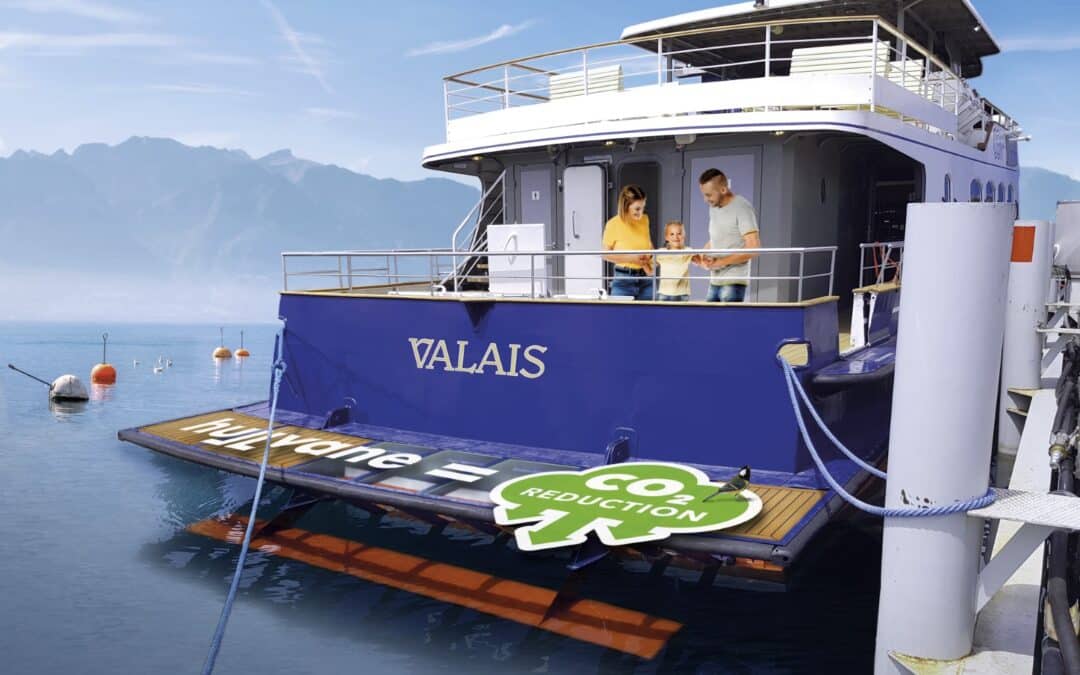Abstract
The maritime industry faces growing pressure to reduce CO2 emissions, comply with stricter regulations, and improve operational efficiency. Hull Vane®, a patented hydrodynamic innovation, offers a proven solution to address these challenges. This article outlines the technology’s principles, its application to ferries, passenger ships, fast supply vessels (FSVs), and Ro-Ro ships, and the measurable benefits achieved in terms of fuel efficiency, emissions reduction, and improved vessel performance.
1. Introduction
Global shipping contributes approximately 3% of the world’s CO2 emissions, prompting regulators and operators alike to seek effective solutions for decarbonization. For vessels such as ferries, Ro-Ro ships, and passenger vessels, where fuel consumption is particularly high due to frequent operations, achieving emissions reductions is both an economic and environmental imperative.
Hull Vane® is a hydrodynamic device designed to reduce ship resistance, enhance fuel efficiency, and lower emissions. Its proven scalability makes it a practical solution for a wide range of vessel types, particularly those operating at medium speeds (12-20 knots).
2. Hull Vane® Technology: Principles and Effects
Hull Vane® is a fixed hydrofoil positioned below the stern of a vessel. Its hydrodynamic design reduces wave-making resistance, generates forward thrust, and improves vessel trim.
Key Hydrodynamic Effects:
- Wave-making reduction: By minimizing the energy lost to waves, the ship requires less power to maintain speed.
- Thrust generation: The hydrofoil generates lift, which contributes directly to forward propulsion.
- Trim optimization: Adjusting the vessel’s trim reduces overall drag, further lowering fuel consumption.
These effects collectively result in measurable reductions in fuel consumption, lower greenhouse gas emissions, and improved stability and comfort during operation.
3. Applications in Ferries, Passenger Ships, FSVs, and Ro-Ro Vessels
Hull Vane® has been applied successfully to various vessel types, with results demonstrating its effectiveness across different operational profiles.
3.1 Ferries and Passenger Ships
Passenger vessels benefit significantly from Hull Vane® due to their high operational hours and fuel consumption. By reducing wave formation, Hull Vane® also improves passenger comfort, leading to a smoother and quieter ride.
3.2 Fast Supply Vessels (FSVs)
FSVs often operate at higher speeds, where fuel efficiency is critical to maintaining profitability. Hull Vane® reduces drag and fuel consumption, extending operational range and minimizing environmental impact.
3.3 Ro-Ro Ships
Ro-Ro vessels, which balance heavy loads with frequent port operations, benefit from Hull Vane®’s ability to optimize trim and reduce resistance, delivering significant fuel and emissions savings.
4. Case Study Insights
4.1 MS Valais (31m Passenger Ferry)
A 31-meter passenger ferry operating on Lake Geneva demonstrated the following results over six years of Hull Vane® operation:
- 15% reduction in fuel consumption.
- 1,000 tons of CO2 avoided, equivalent to the carbon sequestration of 40,000 trees.
4.2 Offshore Patrol Vessel (108m)
Hull Vane® has also been applied to larger vessels, such as a 108-meter Offshore Patrol Vessel (OPV). Despite its size, the vessel achieved:
- 12% reduction in fuel consumption.
- Annual CO2 savings amounting to thousands of tons, contributing to environmental compliance and reduced operational costs.
These cases illustrate Hull Vane®’s versatility and scalability, making it an ideal solution for vessels of varying sizes and operational profiles.
5. Economic and Environmental Benefits
5.1 Fuel Savings and Cost Efficiency
Hull Vane® typically delivers fuel savings in the range of 5-15%, depending on vessel design and speed. For high-consumption vessels, these savings translate into substantial reductions in operating costs.
5.2 CO2 Emissions Reduction
With every ton of fuel saved, approximately 3 tons of CO2 are prevented from entering the atmosphere. For ferries, Ro-Ro vessels, and FSVs with continuous operations, the cumulative environmental benefits are significant.
5.3 Improved Comfort and Operational Efficiency
Reduced wave-making resistance improves vessel stability and comfort, enhancing the overall passenger experience and reducing crew fatigue.
6. Scalability and Return on Investment
Hull Vane® is designed to be scalable, making it suitable for both smaller vessels and ships exceeding 100 meters. The return on investment (ROI) is typically achieved within 2-5 years, depending on fuel prices, operational hours, and vessel type.
7. Conclusion
Hull Vane® is a proven solution for reducing CO2 emissions, improving fuel efficiency, and enhancing vessel performance. Its application to ferries, passenger ships, FSVs, and Ro-Ro vessels demonstrates its scalability and adaptability, making it a valuable tool for shipowners aiming to achieve both economic and environmental goals.
As the maritime industry continues to evolve toward sustainability, Hull Vane® provides a practical and cost-effective pathway to meet regulatory requirements, reduce operating costs, and contribute to global decarbonisation efforts.
